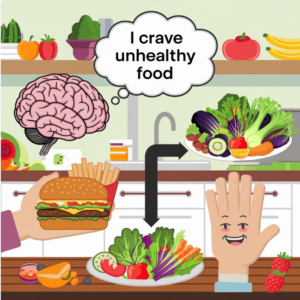I. Cravings
A. What are Cravings
Food cravings are strong desires for specific foods we’ve all felt. They can be hard to resist and often lead to impulsive eating. Cravings usually fall into sweet and salty categories.
They can be caused by both our mind and body. Stress or boredom might make us crave comfort foods. A lack of nutrients can also make us want sweets or salty snacks.

B. The Science of Cravings
Hormones and neurotransmitters play a big role in cravings. Stress can make you want high-calorie foods. Neurotransmitters like serotonin are linked to mood, and craving certain foods can be a way to improve it.
Your gut microbiome also affects cravings. The bacteria in your gut can influence your food preferences. Research shows that your emotional wellbeing is connected to what you eat.
C. Timing and Triggers of Cravings
Cravings don’t happen randomly; they follow your body’s rhythms. You might crave sweets at certain times or after activities. Seeing certain foods or being in social settings can also trigger cravings. Stress often makes us reach for unhealthy snacks.
II. Nutrition‘s Role in Managing Cravings

A. Macronutrients
Understanding macronutrients—carbohydrates, proteins, and fats—is crucial. Protein can make you feel full and reduce hunger. Carbohydrates, especially refined ones, can cause quick cravings. Healthy fats can help you feel full and regulate your appetite.
B. Essential Vitamins and Minerals
Nutrient deficiencies can increase cravings. Make sure to eat a balanced diet. Magnesium, chromium, vitamins B6 and C are important for regulating cravings and mood.
C. Hydration and Cravings
Dehydration can make you feel hungry and reach for snacks. Stay hydrated with at least 8 glasses of water a day. Refreshing drinks like herbal teas or infused water can help without extra calories.
III. Mindful Eating Practices

A. What is Mindful Eating
Mindful eating is about being present and paying attention to hunger. It helps you recognize true hunger and emotional cravings. By focusing on your food, you can enjoy each bite and avoid overeating.
B. Mindful Eating Techniques
To improve your eating, try slowing down and tasting your food. Chewing slowly helps your body feel full and prevent cravings. Use your senses to make meals more enjoyable and satisfying.
C. Building a Healthy Relationship with Food
Positive self-talk can change how you view food. Learn to tell the difference between hunger and emotional cravings. Enjoy food without guilt—remember, it’s okay to indulge sometimes!
IV. Creating a Balanced Meal Plan
A. Components of a Balanced Diet
A balanced diet includes foods from all groups: fruits, veggies, whole grains, proteins, and healthy fats. Eating different colors and types ensures you get all the nutrients. It also makes meals more exciting. Try to balance your macronutrients throughout the day to keep your energy up.
B. Strategic Snacking
Healthy snacks can really help with cravings. Try nuts, yogurt, or fresh fruits to curb hunger and avoid late-night snacks. It’s also key to space out your snacks to keep your energy steady and cravings at bay.
C. Meal Prep and Planning Tips
Meal prep can save you time and help you eat better. Plan your meals for the week, make shopping lists, and prep days to stay on track. When eating out, look for healthy options or ask for substitutions to fit your meal goals.
V. Lifestyle Factors That Affect Cravings
A. Sleep
Lack of sleep can really affect your cravings. When tired, your body craves quick energy, often in the form of high sugar or fat foods. To improve sleep, set a bedtime routine, keep devices out of the bedroom, and try relaxation techniques before bed.
B. Physical Activity and Cravings
Regular exercise can help control your appetite and reduce cravings. Activities like walking, biking, or swimming release endorphins, which can improve your mood. Find activities you enjoy to make it easier to fit in movement.
C. Stress and Cravings
Stress often triggers unhealthy eating. Recognizing this can help you manage cravings. Try yoga, meditation, or simple breathing exercises. Create an environment that supports healthy habits, not stress snacking.
Conclusion
Understanding how nutrition affects cravings can help you have a healthier relationship with food. Focus on balance and mindful eating to manage cravings well. Remember, it’s a journey that needs patience and self-compassion. Take it one step at a time as you work towards your goals.
FAQs
- What are some natural ways to reduce cravings?
- Stay hydrated, eat balanced meals with protein and fiber, and practice mindfulness.
- How can a lack of sleep affect my cravings?
- Sleep deprivation can increase hunger and cravings for unhealthy foods due to hormonal imbalances.
- Is it normal to have cravings daily? Yes, it’s normal to have cravings. The key is learning to manage them instead of giving in to every urge.
- How can I tell if a craving is a sign of hunger or emotional distress?
- Pause and evaluate if your craving is for physical hunger or triggered by emotions, like stress or boredom.
- What foods are effective in preventing cravings?
- Foods high in protein, fiber, and healthy fats, such as nuts, seeds, and whole grains, can help you feel full longer and prevent cravings.

